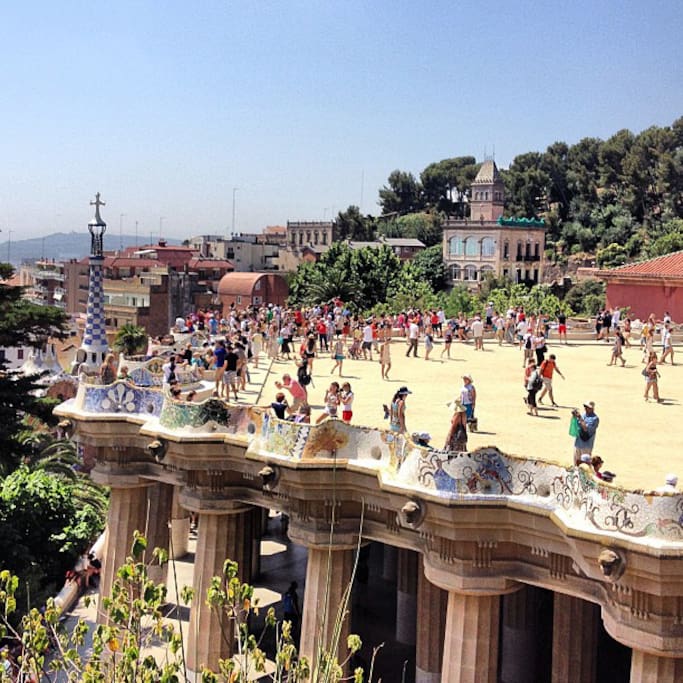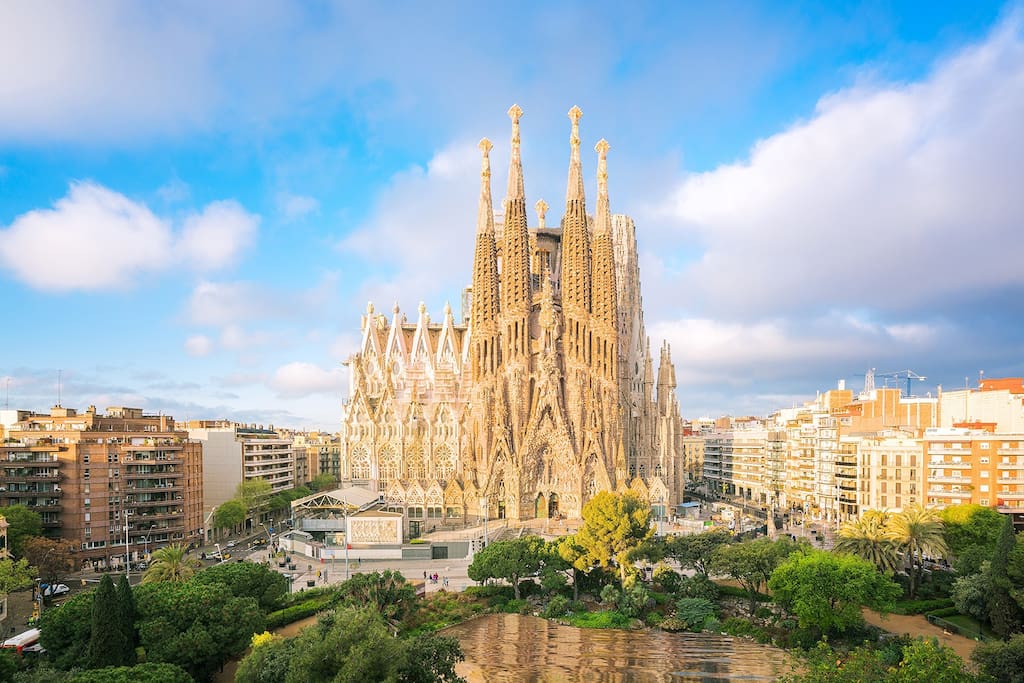Miro Museum
When traveling to Barcelona, you will inevitably come across art works by the artist Joan Miró: when you arrive at the airport, you will be greeted by a huge mosaic of Miró and the city's most representative bank, la Caixa, has a star created by the artist in the logo.
The museum owns over 10.000 paintings, drawings, sculptures, stage designs and carpets from Joan Miró - the earliest drawings are from 1901. On the roof top terrace you can admire Miró's colorful sculptures together with a wonderful view of Barcelona. The Miró museum enfolds by far the largest collection of Joan Miró's works today.
Recommendations for the Miró-Museum
Free admission with the Ar ticket and the Barcelona Card
Get to the Miró-Museum with the Turístic Bus
Close to Plaça Espanya at Parc de Joan Miró, behind the department store Las Arenas, Joan Miró's "Dona i Ocell" (woman and bird), a colorful tribute to the fusion of man and woman, is located. If you're getting to Barcelona via cruise ship over the harbour: even here you are welcomed by Miró's round mosaic face at the Ramblas.
It is worth it, to dedicate your time to Miró's works at the museum Fundació Joan Miró. An opportunity arises to walk from Plaça Espanya to the Miró Museum. Stroll past the MNAC, the Catalonian national museum, through the small Jardí de les Escultures, which is leading you straight to the Fundació.
One of the best Gaudi architecture!!!!! Parc Güell is a privatized park system composed of gardens and architectural elements located on Carmel Hill, in Barcelona, Catalonia, Spain. Carmel Hill belongs to the mountain range of Collserola – the Parc del Carmel is located on the northern face. Park Güell is located in La Salut, a neighborhood in the Gràcia district of Barcelona. With urbanization in mind, Eusebi Güell assigned the design of the park to Antoni Gaudí, a renowned architect and the face of Catalan modernism.
The park was built from 1900 to 1914 and was officially opened as a public park in 1926. In 1984, UNESCO declared the park a World Heritage Site under "Works of Antoni Gaudí".
2138 vendasit rekomandojnë
Parku Güell
One of the best Gaudi architecture!!!!! Parc Güell is a privatized park system composed of gardens and architectural elements located on Carmel Hill, in Barcelona, Catalonia, Spain. Carmel Hill belongs to the mountain range of Collserola – the Parc del Carmel is located on the northern face. Park Güell is located in La Salut, a neighborhood in the Gràcia district of Barcelona. With urbanization in mind, Eusebi Güell assigned the design of the park to Antoni Gaudí, a renowned architect and the face of Catalan modernism.
The park was built from 1900 to 1914 and was officially opened as a public park in 1926. In 1984, UNESCO declared the park a World Heritage Site under "Works of Antoni Gaudí".
Gaudi masterpiece for tourists!!!!
The Basilica i Temple Expiatori de la Sagrada Família, is a large unfinished minor basilica in the Eixample district of Barcelona, Catalonia, Spain, and is currently the largest unfinished Roman Catholic church. Designed by the Catalan architect Antoni Gaudí (1852–1926), his work on the building is part of a UNESCO World Heritage Site. On 7 November 2010, Pope Benedict XVI consecrated the church and proclaimed it a minor basilica.
On 19 March 1882, construction of the Sagrada Família began under architect Francisco de Paula del Villar. In 1883, when Villar resigned, Gaudí took over as chief architect, transforming the project with his architectural and engineering style, combining Gothic and curvilinear Art Nouveau forms. Gaudí devoted the remainder of his life to the project, and he is buried in the crypt. At the time of his death in 1926, less than a quarter of the project was complete.
Relying solely on private donations, the Sagrada Familiar's construction progressed slowly and was interrupted by the Spanish Civil War. In July 1936, revolutionaries set fire to the crypt and broke their way into the workshop, partially destroying Gaudí's original plans, drawings and plaster models, which led to 16 years of work to piece together the fragments of the master model. Construction resumed to intermittent progress in the 1950s. Advancements in technologies such as computer aided design and computerised numerical control (CNC) have since enabled faster progress and construction passed the midpoint in 2010. However, some of the project's greatest challenges remain, including the construction of ten more spires, each symbolising an important Biblical figure in the New Testament. It was anticipated that the building would be completed by 2026, the centenary of Gaudí's death, but this has now been delayed due to the COVID-19 pandemic.
The basilica has a long history of splitting opinion among the residents of Barcelona: over the initial possibility it might compete with Barcelona's cathedral, over Gaudí's design itself, over the possibility that work after Gaudí's death disregarded his design,and the 2007 proposal to build a tunnel nearby as part of Spain's high-speed rail link to France, possibly disturbing its stability. Describing the Sagrada Família, art critic Rainer Zerbst said "it is probably impossible to find a church building anything like it in the entire history of art", and Paul Goldberger describes it as "the most extraordinary personal interpretation of Gothic architecture since the Middle Ages". The basilica is not the cathedral church of the Archdiocese of Barcelona, as that title belongs to the Cathedral of the Holy Cross and Saint Eulalia.
3229 vendasit rekomandojnë
La Sagrada Cerveseria
16 Plaça Sagrada FamíliaGaudi masterpiece for tourists!!!!
The Basilica i Temple Expiatori de la Sagrada Família, is a large unfinished minor basilica in the Eixample district of Barcelona, Catalonia, Spain, and is currently the largest unfinished Roman Catholic church. Designed by the Catalan architect Antoni Gaudí (1852–1926), his work on the building is part of a UNESCO World Heritage Site. On 7 November 2010, Pope Benedict XVI consecrated the church and proclaimed it a minor basilica.
On 19 March 1882, construction of the Sagrada Família began under architect Francisco de Paula del Villar. In 1883, when Villar resigned, Gaudí took over as chief architect, transforming the project with his architectural and engineering style, combining Gothic and curvilinear Art Nouveau forms. Gaudí devoted the remainder of his life to the project, and he is buried in the crypt. At the time of his death in 1926, less than a quarter of the project was complete.
Relying solely on private donations, the Sagrada Familiar's construction progressed slowly and was interrupted by the Spanish Civil War. In July 1936, revolutionaries set fire to the crypt and broke their way into the workshop, partially destroying Gaudí's original plans, drawings and plaster models, which led to 16 years of work to piece together the fragments of the master model. Construction resumed to intermittent progress in the 1950s. Advancements in technologies such as computer aided design and computerised numerical control (CNC) have since enabled faster progress and construction passed the midpoint in 2010. However, some of the project's greatest challenges remain, including the construction of ten more spires, each symbolising an important Biblical figure in the New Testament. It was anticipated that the building would be completed by 2026, the centenary of Gaudí's death, but this has now been delayed due to the COVID-19 pandemic.
The basilica has a long history of splitting opinion among the residents of Barcelona: over the initial possibility it might compete with Barcelona's cathedral, over Gaudí's design itself, over the possibility that work after Gaudí's death disregarded his design,and the 2007 proposal to build a tunnel nearby as part of Spain's high-speed rail link to France, possibly disturbing its stability. Describing the Sagrada Família, art critic Rainer Zerbst said "it is probably impossible to find a church building anything like it in the entire history of art", and Paul Goldberger describes it as "the most extraordinary personal interpretation of Gothic architecture since the Middle Ages". The basilica is not the cathedral church of the Archdiocese of Barcelona, as that title belongs to the Cathedral of the Holy Cross and Saint Eulalia.
Neighborhoods
El Poble-sec is one of eight barris of the Sants-Montjuïc district and spans roughly 460.5 hectares (4.6 sq km) between Avinguda del Paraŀlel and Montjuïc. Official development of the area began in the 19th century and with every decade the neighborhood has seen a variety of changes in its inhabitants, food offerings, entertainment outlets and culture, with the old and the new standing side-by-side on every corner.
Named Poble-Sec—dry village in Catalan—because the neighborhood had no source of water until the late 19th century when a fountain was built, it holds an important place in the history of Catalunya. It was here that American engineer Frederick Stark Pearson set up the Barcelona Traction Light and Power Company to administer the development and implementation of hydro-electric power originating from the Segre and Noguera Pallaresa rivers. Dubbed La Canadenca—the Canadian—by locals because it was incorporated in Toronto, Canada, the factory provided electricity to Catalunya and turned Poble-sec into the industrial capital of Barcelona. The factory brought with it many employees, who took up residence in the neighborhood due to its low-cost housing and close proximity to the factory. While the original plant is no longer operational (Red Eléctrica de España has stood in the same location since 1985), a nod to La Canadenca and the neighborhoods roots still exists in the form of the original smoke stacks, which tower over Poble-sec.
92 vendasit rekomandojnë
El Poble-sec
El Poble-sec is one of eight barris of the Sants-Montjuïc district and spans roughly 460.5 hectares (4.6 sq km) between Avinguda del Paraŀlel and Montjuïc. Official development of the area began in the 19th century and with every decade the neighborhood has seen a variety of changes in its inhabitants, food offerings, entertainment outlets and culture, with the old and the new standing side-by-side on every corner.
Named Poble-Sec—dry village in Catalan—because the neighborhood had no source of water until the late 19th century when a fountain was built, it holds an important place in the history of Catalunya. It was here that American engineer Frederick Stark Pearson set up the Barcelona Traction Light and Power Company to administer the development and implementation of hydro-electric power originating from the Segre and Noguera Pallaresa rivers. Dubbed La Canadenca—the Canadian—by locals because it was incorporated in Toronto, Canada, the factory provided electricity to Catalunya and turned Poble-sec into the industrial capital of Barcelona. The factory brought with it many employees, who took up residence in the neighborhood due to its low-cost housing and close proximity to the factory. While the original plant is no longer operational (Red Eléctrica de España has stood in the same location since 1985), a nod to La Canadenca and the neighborhoods roots still exists in the form of the original smoke stacks, which tower over Poble-sec.
Këshilla për qytetin
Si të lëvizësh
Travel cards for getting around Barcelona
Mobility in Barcelona and its metropolitan area is easy as a result of an ever-more sustainable public transport network – metro, trams, buses and the Catalan government's city and suburban rail service (FGC) – which prioritises clean energy. The city also has a public bike hire scheme and more than 200 km of bike lanes; a fleet of taxis that includes hybrid and electric vehicles and cabs running on natural gas.
T-10 casual card which is valid for 10 journeys costs 11.95 euros


